

The Fortean Fallacy!
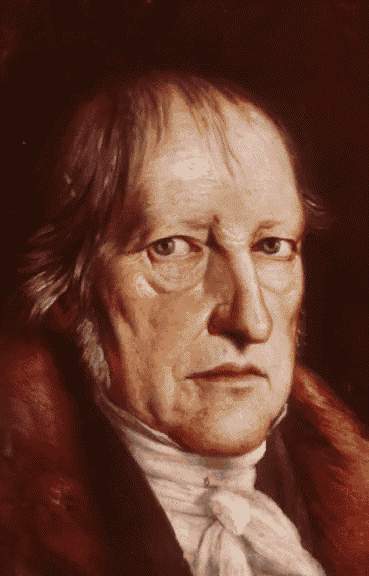
 |
 The Fortean Fallacy! |
 |
New York eccentric Charles Hoy Fort (1874–1932) really started something. The obsessive hobby which occupied the last 26 years of his life led to four published books— The Book of the Damned, New Lands, Lo!, and Wild Talents— which appeared between 1919 and 1932. These books are perfect examples of the classic pseudoscience activity of research by exegesis. Fort haunted the British Museum in London and the New York Public Library, noting any event reported in old magazines and newspapers— the older the better— which in any way seemed “odd.” Fort enjoyed taking several hundred such odd events and using them to prop up a scenario “theory”— the wilder the better. Fort equally enjoyed contradicting himself; instead of riding the hobbyhorse of a single crazy scenario, like most modern pseudoscientists, Fort offered numerous totally inconsistent ones. For example, in one place he speculates that the earth is relatively stationary in a space that is surrounded by an opaque shell, full of holes (the stars and planets) and with areas which are mushy or jelly-like. Between the shell and the earth are gigantic floating islands of more jello, to which stick tons of rubbish— worms, fish, dead birds, bricks, worked stone, worked iron, liquids of various colors, frogs, statues, blocks of ice, mammoths and dinosaurs, sea monsters, unclassifiable alien creatures, snakes, odd humans like Kaspar Hauser— which has somehow blown there or drifted there from other inhabited regions somewhere off the earth. Once in a while a bundle of such debris drops down to earth, and the inhabitants of some village or community marvel at the blood-red rain, or the salmon, or the frogs, that pour down from the sky! Fort did not take anything he wrote seriously, and his books are intentionally very funny— a really rare thing, given that one of the distinctive features of pseudoscience is its total lack of humor, apart from misplaced sarcasm and unintended humor. On the other hand, Fort, following perhaps unwittingly in the footsteps of Georg Wilhelm Friedrich Hegel, was quick to point out that in his opinion all the claims, facts, theories and discoveries of science were just as absurd and false as Fort’s own speculations. Fort, who knew nothing whatsoever about science, had not the vaguest idea how scientists investigate, confirm, test, invalidate or validate an idea. He was not so much a pseudoscientist as he was one who seems to believe, like Hegel and his more recent disciple, Paul Feyerabend, that there is no difference between science and pseudoscience; his decades of exegesis were intended to demonstrate mainly that “reality” is probably ultimately unknowable, and that the smug certainties of science are achieved mainly by sweeping aside and ignoring all the “unpleasant facts” that don’t fit in with supposed scientific dogmas.
As a critic of science, Fort is of no interest whatsoever, because he was totally ignorant of what science is and what scientists do. But his impact on pseudoscience was immense. Fort taught the field of pseudoscience that all you need to write a book is a subscription to some newspapers and good sharp scissors (today, a personal copier or scanner) plus a scrapbook to paste it all in (today, a computer to store it all in). Since newspapers and magazines publish vast amounts of “weird” and “strange” reports, one just has to keep clipping until one has enough for a book— of course, one never investigates directly to see whether these reports actually correspond to real events! That would spoil the fun; it would also no longer be pseudoscience.
The two most serious modern Forteans— a Fortean being one who occupies himself clipping or otherwise saving weird reports out of old magazines and newspapers, like Fort himself— are Vincent H. Gaddis (1913 - 1997) and William R. Corliss. Gaddis is the unsung inventor of the Bermuda Triangle hoax. Corliss is the creator of a number of vast tomes full of questionable reports on a wide variety of topics, as part of what he calls his “Sourcebook Project.” Both Gaddis and Corliss completely lack the wit and literary elegance that make Fort’s books such fun to read. Many other writers have followed in the footsteps of Fort and Gaddis particularly, sometimes coming quite close to directly plagiarizing Gaddis' and Fort's works. The 1950s through the 1970s were a particularly ripe time for Fortean compilations on a wide variety of strange topics. Some successful modern Forteans include Charles Berlitz, Jacques Bergier, Ivan T. Sanderson, Morris K. Jessup, Robert Charroux, John Wallace Spencer, D. Scott Rogo, Martin Ebon, Frank Edwards, Harold T. Wilkins, W. Raymond Drake, and the list goes on....
Such book-producing Forteans should not be confused with members of the Fortean Society, a club founded in 1931 by members of the New York novel-writing profession, including Tiffany Thayer, Alexander Wolcott, Booth Tarkington, and Ben Hecht. The Fortean Society was merely an excuse for buddies to get together, hear exceptionally valueless speeches after a good dinner, and then drink one another to the carpet.
Fort's critique of science is based on the misconception of science as a kind of secular priesthood, deciding arbitrarily what is “true” and what is “false” without regard to the evidence. In this aspect, Fort is rightly viewed as a forerunner of most of today's Postmodernist critics of science, who explicitly deny the very existence of scientific fact or of scientific progress, and like Fort view science purely as a “social construct.” Attacks on science, scientists, and often all forms of scholarship, are found in many if not most pseudoscience books. However, many pseudoscientists, from J. B. Rhine, Immanuel Velikovsky and Rupert Sheldrake, on down to the Intelligent Design cultists, do not accept the facts of science for what are essentially religious reasons. Fort's critiques are not based upon perceived conflicts between science and any religious dogmas; in fact, Fort proudly claimed to be completely dogma-free. However, the Fortean approach is always a comfortable fit for science-haters with any personal ideologies that can't exist within established reality. On his website, arch-Fortean William R. Corliss modestly summarizes the well-established facts that the superstitions he has collected supposedly call into question: “The expanding universe; The Big Bang origin of the universe; Neo-Darwinism (specifically, evolution via random mutation and natural selection); That genomes are the complete blueprint for life-forms; Plate tectonics/continental drift; Special and General Relativity.” Strangely, he doesn't mention quantum physics! Many religious conservatives position themselves as Christian Forteans, and this kind of Forteanism has had a terrifically negative impact on science education in “Red State America.” Indeed, the Creationism/Intelligent Design Movement is a very pure example of extreme, Bonehead Forteanism.
We might define Fortean activity in general as the collection of magazine and newspaper or Internet reports of “odd” or “impossible” phenomena, and the grouping of such phenomena by “type,” followed by the claim to have learned something from reviewing the reports of the phenomena. The “something” generally tends to be an absurd science-fictional scenario— that all these missing cats have wandered into the 19th Akasic dimension, that’s why they’re never seen again on this earth! Further, these reports are always taken precisely at face value. There is never the slightest attempt at checking or verification. As most are aware, there have been for a number of years tabloid newspapers and one or two magazines which exist principally to print or reprint “real” or completely made-up Fortean style material. Most of the tabloids that sit near drugstore checkout counters are of this kind— BIGFOOT STOLE MY WIFE! TV STARS CURSED BY INDIAN MEDICINE MAN! GHOST OF J. F. K. HAUNTS U.S. AIR FORCE! “SIMPLE LIFE” STAR’S EXPERIENCE WITH REINCARNATION! and so on; with the difference that essentially the entire content of most such tabloids is literally made up on the spot by the writers sitting at their word processors, which short-cuts the laborious clipping procedure, while insuring (most importantly) that the desired celebrities are mentioned as being involved somehow. A more traditional Fortean publication is the magazine Fate, which began publication in 1948, founded by infamous science fiction magazine editor Raymond A. Palmer. A similar, but more light-hearted publication is The Fortean Times, available monthly since 1973.
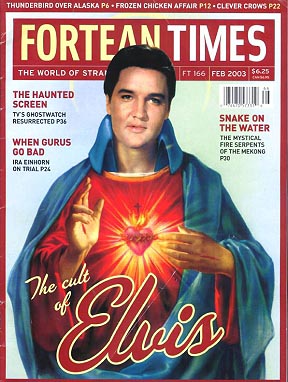 |
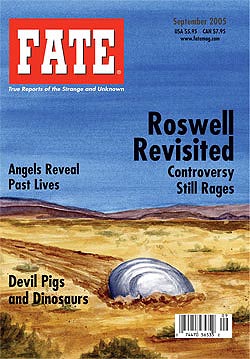 |
A fairly large percentage of all pseudoscience books published in the 20th century have had a basically Fortean format. After Fort’s own books, the most successful were Fortean books on “flying saucers” or UFOs that appeared in the early 1950s. The success of these books led pseudoscientists to create Fortean books on a vast number of other topics, including mysterious disappearances of ships and aircraft at sea. The classic modern Fortean book is a collection of ghost stories, “ESP experiences,” recollections of near-death experiences, reports of Bigfoot or the Yeti or the Loch Ness Monster, reports of reincarnation experiences, reports of “spontaneous human combustion,” reports of “alien-abduction experiences,” reports of “mysterious” crop circles, etc., etc., etc.
The very strong elements of humor and sharp wit in Fort's books have misled some readers into thinking he did not intend to be taken seriously. Fort would have been a very strange individual indeed if he had not realized the extreme ridiculousness of most of the “authentic reports” he uncovered. He has fun with his material. But as a critic of science he expects to be taken seriously. And it is precisely at that level, as a critic of science, that he fails completely and utterly.
The deliberately absurd scenarios in which Fort delighted in his four “nonfiction” works are the concoctions of a man who perhaps would far rather be writing outright science fiction.
For more about Charles Fort, see:
→ Skeptic's Dictionary entry on Charles Fort.
→ A very brief biography of Fort.
• Some examples of Fort's influence on fantasy fiction. Another writeup on the same topic.
• A rare writeup on William R. Corliss, the busiest modern Fortean.
• About the only writeup on Vincent H. Gaddis.
• Fortean reports generated wholesale just to advertise a new video game!
Some modern “amazing phenomena” in the spirit of Fort: Crop Circles! The Bermuda Triangle! (invented by Fort follower Vincent H. Gaddis) Ica Stones! Crystal Skulls! Chupacabra! Hundredth-Monkey Hoax Vinyl Vision!
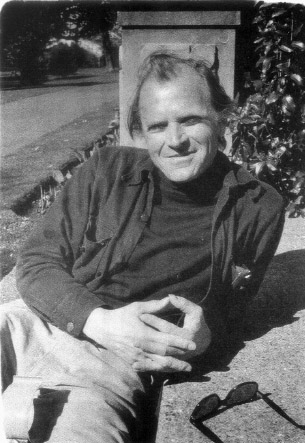 |
 A typical Fortean phenomenon! |
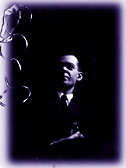 |